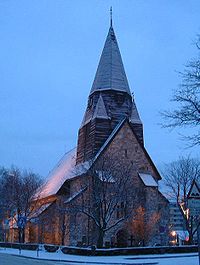
Vossevangen
Encyclopedia

Voss
is a municipality in Hordaland county, Norway. It is part of the traditional district of Voss. The administrative center of the municipality is the village of Vossevangen....
municipality in Hordaland
Hordaland
is a county in Norway, bordering Sogn og Fjordane, Buskerud, Telemark and Rogaland. Hordaland is the third largest county after Akershus and Oslo by population. The county administration is located in Bergen...
, Norway
Norway
Norway , officially the Kingdom of Norway, is a Nordic unitary constitutional monarchy whose territory comprises the western portion of the Scandinavian Peninsula, Jan Mayen, and the Arctic archipelago of Svalbard and Bouvet Island. Norway has a total area of and a population of about 4.9 million...
. The population is about 5500. It's located in the center of Voss
Voss
is a municipality in Hordaland county, Norway. It is part of the traditional district of Voss. The administrative center of the municipality is the village of Vossevangen....
at the north-east edge of Vangsvatnet
Vangsvatnet
Vangsvatnet is a lake in the municipality of Voss in Hordaland county, Norway. The lake is used for various water based extreme sports activities like Kite surfing and boat dragged paragliding. The Vosso River flows through both Vangsvatnet and Evangervatnet before it empties into Bolstadfjord by...
.
Vossevangen takes its name from the Old Norwegian word vang (Norse
Old Norse
Old Norse is a North Germanic language that was spoken by inhabitants of Scandinavia and inhabitants of their overseas settlements during the Viking Age, until about 1300....
Vangr) that can mean field or meadow, and refers to a large grass field lying between the church and Vangsvatnet. Voss is situated on the main road and railway line from Oslo to Bergen, about 100 kilometres east of Bergen.
According to legend, the people of Voss were forcibly converted to Christianity by king Olav, who later became St. Olav. A stone cross situated in Vossevangen is said to have been erected at this time. The town contains a stone church from 1277, with a 16th century excentric, octagonal steeple. Just outside the town is Finnesloftet, a wooden guildhall believed to be the oldest profane wooden building in Northern Europe.
After the German invasion of Norway on April 9, 1940, Voss was the main point of mobilisation for the Norwegian Army in the west, as the city of Bergen had already fallen on the first day of the invasion. Although most of the troops mobilised here were transferred by railway to the fighting in the east of the country, the German forces, advancing towards Voss along the railway line from Bergen and from the Hardangerfjord, were met with stiff resistance. In Hardanger, some of the Germans climbed up the mountains from Ålvik while the rest went through Granvin. To break down this resistance the town of Voss was bombed by the Luftwaffe on 24 and April 25. About a dozen civilians lost their lives in the bombing which completely destroyed the old wood-built town centre. On April 27, the German forces entered the town, which remained occupied until May 8, 1945.

